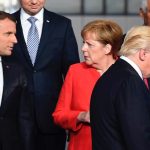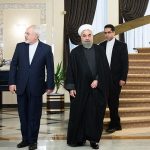by Djavad Salehi-Isfahani
As Washington gets ready for President Trump to throw the first stone in the killing of the Iran nuclear deal next week, Iranians are trying to preserve their hard-won gains from the agreement. After three years of recession, mainly caused by international sanctions, in the 18 months since the agreement went into effect in January 2016, Iran’s economy has come roaring back.
And this, rather than violation of the “spirit of the agreement” by Iran, may be the real problem for the Trump administration and the neoconservatives who would like to reverse Iran’s rising profile in the region. The other signatories to the nuclear deal, the three European powers plus Russia and China, seem firmly behind the deal, so moving away from the deal and trying to re-impose sanctions with a global reach will be an uphill battle for the US.
The previous sanctions regime that in 2012 hit Iran’s economy hard, causing its currency to crash and inflation to skyrocket, benefitted from the fear of Iran developing nuclear weapons. With the International Atomic Energy Agency watching and certifying that this is not the case any more, for most countries the logic for isolating Iran is simply gone.
The US can certainly threaten the flow of foreign investment into Iran that is just beginning to move from promise to action. Foreign direct investors are attracted to Iran by its low foreign debt, good economic prospects, decent infrastructure, and educated labor force. But they are not likely to brave hell or high water to make money in Iran. For many, losing access to the huge US market and fears of military action are enough to scare them away.
Moreover, the expected benefits from investing in Iran are conditional on internal economic reforms, which President Hassan Rouhani has promised and labeled barjam 2, using the Persian acronym for the Joint Comprehensive Plan of Action (JCPOA). His critics at home are already attacking him for subjecting the country to a humiliating deal that has borne little fruit.
The good news for Iran and Rouhani is that so far economic recovery has not depended much on foreign direct investment (FDI), so the country should be able to maintain modest growth with its local resources—as long as Iran can stick to the nuclear agreement and thereby stave off globally enforced sanctions.
Fast but Narrow Economic Recovery
Iran’s economic recovery was slow to materialize after the JCPOA was signed but rebounded vigorously once it went into effect. Two aspects of this recovery are noteworthy. First, it was mainly spurred by the easing of sanctions on trade, in particular oil exports, not investment. National output increased as a result of increased utilization of existing capacity rather than its expansion. Second, it was narrowly based on oil exports with limited impact on employment. In fact, unemployment has increased continuously since Rouhani took office as the rising population of youth, who were absorbed by the rapid expansion of higher education during the Ahmadinejad years, enters the labor force.
According to provisional figures published by the Central Bank of Iran (CBI) during the Iranian fiscal year 2016/17 (March 21, 2016 to March 20, 2017), the economy grew at a fast rate of 11.5%, but much of it was due to rising oil output. Iran’s oil exports responded rapidly to the easing of sanctions, doubling in one year.
Revenues from oil exports have always been slow to trickle down to the non-oil economy, where Iranians work. Estimates of the growth of non-oil GDP in 2016/17 differ depending on the source: 3.3% as reported by the CBI and 6.3% by the Statistical Center of Iran (SCI). SCI registers faster growth for the services sector, which accounts for its more upbeat estimate. SCI data show that the non-oil economy has continued to grow during spring 2017, at a robust rate of 7%.
Spring 2017 is the second quarter the construction sector has registered a positive growth. Recovery in the real-estate sector, which is also evident in the 39% increase in real-estate brokerage activity in 2016/17, is essential for Iran’s frozen banking sector to recover from the collapse of real estate since 2011.
Impact on the Ground
These developments have not yet affected the lives of ordinary Iranians. During spring 2017, unemployment stood at 12.6%, 0.4 percentage points higher than the corresponding quarter a year ago and 2 percentage points higher than when President Rouhani entered office in 2013.
Economic growth has not been jobless. Last spring, 700,000 more people were working: 200,000 in industry and the rest in services. The reason for the poor unemployment picture is labor-force participation, which rose from 39.5% in spring 2016 to 40.6% in spring 2017. This is in turn the result of students graduating from college and mostly joining the pool of the unemployed. During the same period, the unemployment rate for youth 15-29 years old rose from 24.9% to 26.4%.
The lackluster employment record is partly because investment has not yet fully recovered. SCI data show that gross fixed capital formation continued to decline in 2016/17, though it grew by less than one percent in spring 2017. If Trump’s actions scare away FDI, domestic sources for investment have to grow. For this to happen, among other reforms, Iran must solve its banking crisis and bring interest rates down from their historic record high levels of 10 percent in real terms.
Renewed US sanctions will surely present serious challenges for President Rouhani, who had hoped to have an easier second term, reaping the benefits of the nuclear accord. But these challenges will be less severe than those Iran faced in 2011, when the Obama administration first tightened sanctions. Iran learned a great deal from that experience and now faces a more favorable global climate.
Obama’s sanctions hurt Iran’s economy and its people, brought Iran to the negotiating table, but failed to change Iran’s foreign policy. It is doubtful that new sanctions will bring Iran back to the negotiating table, much less affect its foreign policy.






Trump, but also previous US leaders, have this “exceptional” attitude which sees them destroying other countries via sanctions,behaving as big bullies punishing disobedient underlings. If only the rest of the world would stop giving in to the US bossiness, the people who do not live in the USA could more easily get on with their lives, work, trade, even thrive!
“certifying that this is not the case any more” — the IAEA had never claimed that Iran in face EVER making nukes, quite the contrary they specifically stated that there was no evidence for that. Both ElBaradei and Amano personally stated so. Not pre-2003, not post-2003, never. The IAEA could only ever point to scattered and incomplete “studies relevant to” nukes, which are not a violation of the NPT whatever they were.
Sanctions affect not only the seller but also the buyer, and US sanctions on Iran (first) and then Russia (next) have hurt Europe as well as the two targeted countries. So the GDP growth rate is only 1.6 in France and 2 in Germany. Now that Iran is back up to 3.5 perhaps Europe will increase also, if not further hindered by the US.
Of course the US sanctions strategy is meant to hurt all of the chief US financial competitors, but the situation is changing. The big story to watch is possible replacement of the dollar as the world reserve currency, which might be precipitated by China’s offer to buy oil in Yuan convertible to gold.
I agree with donbacon, should the USD be ever replaced, the US will suffer significant losses and turmoil. The era of complacency is over. After WW2, the UK passed from the net creditor to debtor position. The US has been able to finance its deficits and entitlement thanks to the USD being the global reserve currency. Any move away from the USD bears systemic risks for the US but also the global economy. It will not be a sudden change but powers are shifting east. That said, the US was a global defender of democracy except where interests clashed with values, it doesn’t bode well for democracies.